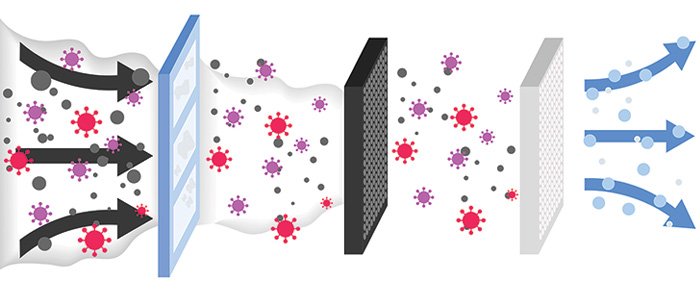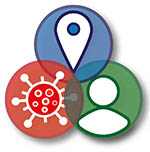
How we know that HEPA filter based air cleaners are likely to be beneficial for reducing transmission of respiratory infections.
In this blog post, PROTECT NCS researchers Professor Cath Noakes and Alan Beswick discuss how HEPA filter based air cleaners can reduce transmission of respiratory infections.
As we enter the coldest months of the year the combination of cooler, damper weather will cause most of us to close window and doors in order to keep our homes, social spaces and workplaces warm. In 2022 this is more relevant than ever, given the huge increases in gas and electricity prices within the UK and across Europe. For many of us, this will result in reduced levels of ventilation within the indoor spaces we inhabit. With such a trend almost inevitable during the winter months, and happening at the same time that respiratory viral infections peak, the most vulnerable in society are the most likely to be affected by increase in flu’ or Covid19 over the coming months. With this in mind, filter based air cleaners are one option to reduce the likelihood of indoor transmission of such infections indoors.
Filter based air cleaning devices are designed to remove particulate material from the air, usually in the background while the treated room is occupied. This includes any airborne microorganisms, often called bioaerosols. There are many types of air cleaner on the market and these vary considerably in terms of size, the room space they can treat and the types of technology they contain. Some air cleaners are mobile-floor-standing devices, others are installed on a wall or ceiling, but all operate on the same principle – a fan draws air through one or more filters, which removes particles. If the filter is effective, it can remove over 99% of all particles in the air that passes through it.
The claims made about the benefits of air cleaners have been widely publicised, especially in the context of the Covid-19 pandemic, so it’s important to remember that their use is not a replacement for effective mechanical or good levels of natural room ventilation. Indeed, they are most effective in rooms where the ventilation rate is lower than desired and/or is difficult to provide consistently. For example, this can include rooms that rely on opening windows for ventilation, and where closing windows in cold weather reduces the ventilation rate substantially.
How do we know Air Cleaners work?
A review undertaken by SAGE for UK Government in 2021 concluded that air cleaning devices using germicidal UV and/or High efficiency particulate arrestance (HEPA) filters are most likely to achieve safe and effective bioaerosol removal. Other air cleaning systems, such as those emitting free radicals or creating ionising effects, are available but were deemed less likely to have the impact required to influence airborne disease transmission, based on evidence available at the time of that review.
The performance of air cleaners has been studied over many years, since well before the Sars-CoV-2 virus came to the public’s attention. Over this period there has been growing evidence from computational models, laboratory testing and ‘real’ use studies that air cleaners based on HEPA filters can be effective at reducing the concentration of particles in the air and therefore are likely to be able to reduce exposure to respiratory particles in the air that carry virus. Despite this interest there has not been much data that measures the impact of these portable devices on microorganisms until recently.
A study carried out at Addenbrookes hospital using a large HEPA filter device with added UVC showed that the concentration of microorganisms in air was very substantially reduced when the device was operational. This study measured the presence of microorganisms using molecular techniques which are not able to detect whether the microorganisms are alive or dead, but showed that the level of SARS-CoV-2 RNA in air was reduced as well as a number of other bacteria and fungi. A Japanese study in a controlled chamber was one of the first to deliberately test the effect of a HEPA filter against an artificial aerosolization of the SARS-CoV-2 virus in a very controlled setting and showed the filter was very effective at reducing RNA concentrations in air. And a study in the USA placed people who had Covid-19 into a controlled chamber, and showed that with a HEPA filter present the concentration of SARS-CoV-2 RNA in air was reduced.
A new UK study carried out by members of the PROTECT National Core Study has further added to this evidence base to support the benefits of air cleaners, based on controlled experimental assessments of several devices. These experiments were carried out in a biological aerosol chamber where a microorganism can be safely aerosolised without posing a risk to people. The study compared the rate at which the microorganism concentration in the air is reduced over time by the chamber ventilation alone, and when an air cleaning device is added to the chamber. Under these test conditions, all the selected air cleaners had a beneficial effect on microbiological air quality. The devices were challenged using bioaerosol concentrations that were probably far higher than most real world situations would create. Some devices performed well under these conditions, reducing the concentration below the experimental detection threshold, with the best achieving greater than 5 orders of magnitude reduction in bioaerosols per m3 of room air.
Practical application of air cleaners
All of these results provide evidence that HEPA filter air cleaners are effective at removing microorganisms from the air, as well as other particles such as dust, soot and pollen. However, an air cleaner’s effectiveness in reducing airborne disease transmission will depend on the situation it is being used in and on the contribution of small aerosols to the transmission of the infection. This is especially relevant because air cleaners will be most effective at reducing risk from infectious particles that stay airborne over longer distances (i.e. those travelling beyond 1-2m from source). If a disease is normally spread by contaminated surfaces or by close range inhalation then air cleaners will have a more limited impact in reducing transmission. Where airborne transmission of a disease is important, these devices will nearly always offer some benefits in reducing the risk of exposure
The rate at which the air is cleaned depends on how much air passes through the device. This in turn depends on a measure called the Clean Air Delivery Rate (CADR), which expresses the amount of clean air provided by the device, in m3 per hour. This value is often mentioned in the advertised information for the air cleaner and can be used to size a device to provide an appropriate amount of air for a room. Even when the device cleans air effectively, if it does not distribute the air well in a room, it may not be very effective. Some devices create “short-circuiting” whereby the device moves air in the immediate vicinity of the device, but doesn’t manage to mix the air in the wider room. It can be difficult to identify devices which provide good air mixing, although some manufacturers have carried out Computational Fluid Dynamics modelling or other forms of airflow analysis to optimise the design of their device.
Positioning devices can help with overcoming the short-circuiting risk, with devices positioned away from walls and not blocked by furniture to allow air to pass into and out of the device effectively. In larger rooms it may be better to have several smaller devices rather than one very large device. This can offer convenience in terms of more easily locating the smaller device(s), but also allow flexibility and improved efficiency by having air cleaners circulating cleaned air in different parts of the room.
There are a number of considerations with implementing HEPA-filter units including noise, the physical location and robustness of the device, the cost to purchase, install and run, and the maintenance of the device.
Devices are likely to have the greatest impact in rooms where people spend longer periods of time together (classrooms, offices, hospitality, healthcare, care homes). They may be particularly useful in community spaces set up as “warm banks” which are designed to provide a social space for people who may be vulnerable and are not able to effectively heat their own home. Many air cleaners have relatively low energy consumption, and although it is always important to ensure there is some ventilation, they may provide a more energy efficient strategy than opening windows wider, particularly in inclement weather.
While air cleaners are not a panacea and they will not remove all risk of exposure to pathogens in air, there is good evidence that they can provide a cost effective and straightforward to implement solution that reduces airborne infection risk. In the long term it is important that ventilation is improved in many buildings to ensure environments are resilient for future pandemics, but in the short term air cleaning is a solution that should be given much more consideration.
Alan Beswick is a Principle Scientist at the HSE Science and Research Centre, and led the new PROTECT study on measuring the performance of air cleaning devices.
Cath Noakes is a Professor of Environmental Engineering for Buildings at the University of Leeds, and she is the lead for theme 2 of the PROTECT NCS.






0 Comments